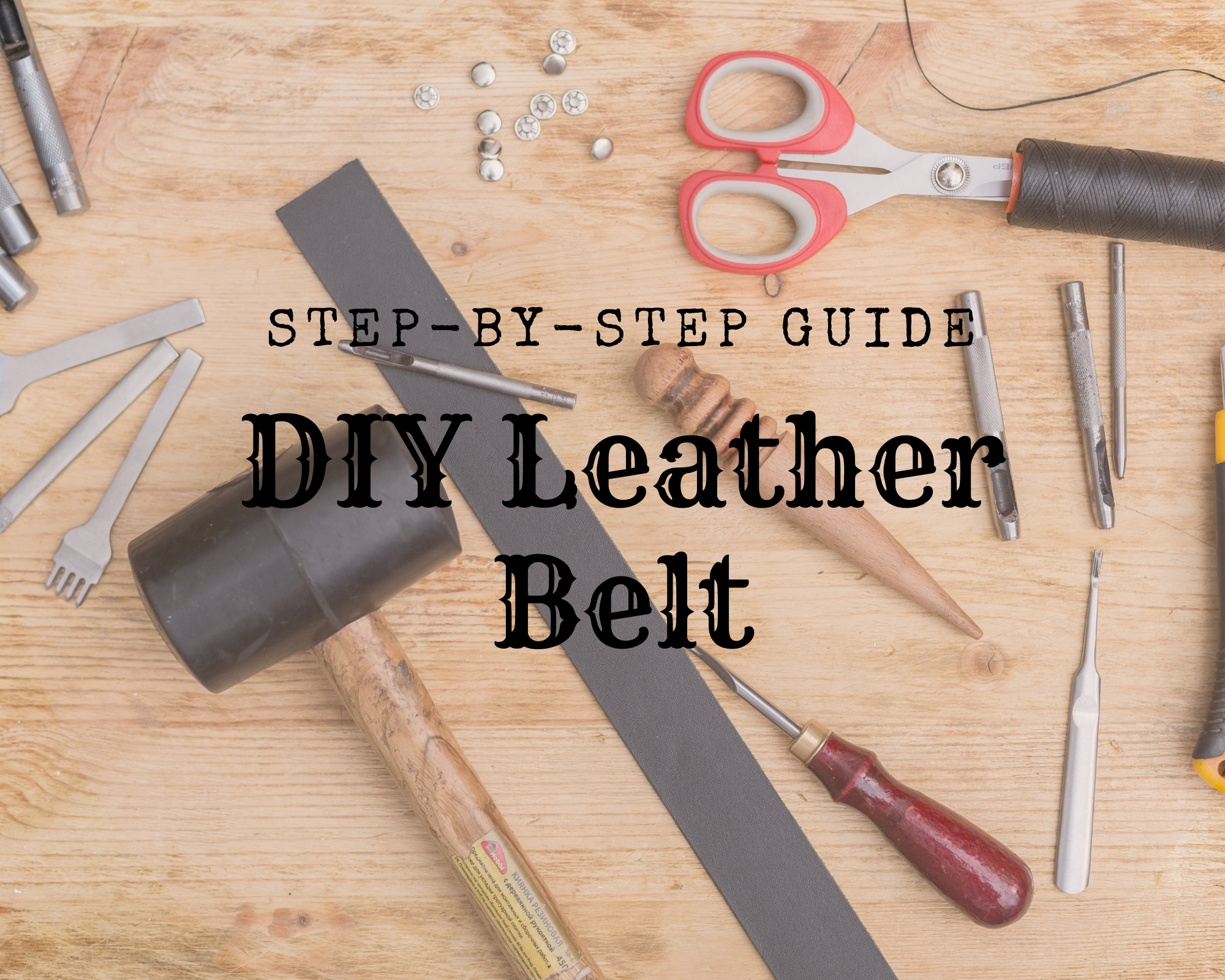It is now a part of the new normal to wear face masks everywhere we go. We have to wear one the moment we step out of our houses. Ever since the pandemic has started, more and more people have been using masks of different makings and materials — paper, neoprene, fabric, and even leather. I’m here to teach you the steps on how to make your own leather face mask.
How to make a leather face mask? To create a leather face mask, you will need the basic leatherworking tools such as a knife, leather awl or puncher, a hammer, two needles, some leather, waxed thread, and button studs. You will also need a pattern of the face mask you’ll be making. This is a project that leatherworking enthusiasts will find fun and profitable at the same time.
In this article, we will discuss the step-by-step procedures on how to make a leather face mask that you can use for your daily wear or when going out on a commute, including the materials and tools you’re going to need. This is a project that is timely given the current situation we are all in right now.
- Let’s Start with The Materials and Tools You’ll Need:
- Steps on How to Make Your Leather Face Mask
- Preparing the Pattern
- Pasting the Pattern on the Leather
- Punching the Holes on the Leather
- Beveling the Edges of the Cut Leather
- Stitching to the Center of the Leather
- Stitching Towards the Edge of the Mask
- Making the Filter Pockets
- Pasting the Filter Pocket into the Mask
- Sewing the Whole Edges of the Mask Together
- Smoothing the Edges of Your Leather Face Mask
- Punching Holes for the Straps
- Making the Face Mask Straps
- Attach the Straps to the Face Mask
- Putting the Filter On and Other Finishing Touches
Let’s Start with The Materials and Tools You’ll Need:
All You Need are Basic Leatherworking Tools

This project does not require expensive or advanced tools to begin with. There is no need to buy additional tools for this project. We are going to use the basic tools that we have in our tools holder. Make sure to have leather gloves and a cutting mat for safety purposes and also to protect the surfaces of our workstations.
Perfect Tools for the Perfect Mask
You will need a leather pricking iron to guide you in punching holes. You will also need an awl and a flat side awl that you’ll use closely with the pricking iron to punch holes into the leather. A hole punch (2mm/3mm diameter) and an oval punch is also needed for the same purpose of making holes.
You may use an edge beveler for finishing purposes. You will be needing two stitching needles. It is recommended to use John James needle #4 for this project. Lastly, you will need a wood slicker for the finishing touches.
Additional Materials You’ll Need
Of course, you need to have leather with you on this project. For this one, it is recommended to use 1.8mm 3 to 4 oz veg tan or Buttero 4oz. These are thick enough but not too thick for the face masks. You will also need the pattern for the face mask, along with the waxed thread. As for the thread, you can use Vinymo MBT #5. You’ll be needing glue to bond pieces of leather together. Intercom ecostic 1816b is highly suggested for this one. You must have button studs (4 pcs 4mm diameter) too as well as some sandpaper (400 grit) for finishing and smoothing edges of the cut leather.
Steps on How to Make Your Leather Face Mask
It is very important to note that you have to follow the pattern closely so that you won’t make mistakes or end up wasting lots of leather for this project.
Preparing the Pattern
First, you must print the pattern for the face mask. Set your printer to US paper, 100% actual size option for more accurate measurements. Then, cut out the pattern with some margins for allowance.
Pasting the Pattern on the Leather
Next, cut the leather to bond pieces together. You can use masking tape in pasting the pattern to the leather. After cutting the leather according to the pattern, paste them together using glue. This is where the Intercom ecostic 1816b comes into play.
Punching the Holes on the Leather
You need to punch holes on the face mask since leather is thicker than cloth or most face mask materials. Holes are needed for air flow. Following the pattern again, you have to make 3mm and 2mm holes. Cut along the outline of the pattern.
Beveling the Edges of the Cut Leather
Next, we have to do beveling to smooth the edges and avoid stray strands. A regular beveler will do for this one. Then, make a stitching guide 4mm inward from the edge. Beveling is important to avoid having frayed edges and loose strands due to the cutting process. By beveling, you smooth the edges so that it would look more trimmed and clean.
Stitching to the Center of the Leather
Mark stitching holes before chiseling. Use the pricking iron in guiding holes. Remember that pricking holes is different from punching holes. A pricking iron is used for guiding the holes while chisel is used in poking the holes made by the pricking iron.
Make sure the number of holes match both sides. It is recommended to use 4mm diamond chisel for holes. Put the two pieces together, the outer sides facing each other. Now, it is ready for stitching.
Stitching Towards the Edge of the Mask
Saddle stitch towards the edge of the mask, starting from the center all the way to the edges. A leather clamp pony can be used so that two hands can be used in stitching. Otherwise, just clamp the leather securely if you don’t have a clamp pony at home.
After sewing, turn the pieces inside out to check the shape. Push the center since leather is harder. Make sure corner parts are there for your nose and chin. The goal here is to ensure your lower face is covered and fits snugly.
Making the Filter Pockets
Filter pockets are needed for this face mask since leather has no filtering properties unlike surgical masks or N95 masks. Use the guide for cutting inner layers. Bevel inner layer to smoothen edges. Then, sew the center first to bind them together towards the end of the stitching guide. Turn it inside out just like what we did in the mask. Fold the sewn edges to make it more malleable, then cut corners for a snug fitting.
Pasting the Filter Pocket into the Mask
For this one, you have to scratch the inner side of the outer layer of the filter pocket. Then, glue the inner layer to the outer layer. Make sure it fits the centers and corners. Also, make sure the glue is applied well or else it gets messy.
Sewing the Whole Edges of the Mask Together
Make stitching guides according to the holes on the outer layer. Saddle stitch to sew ends of the mask together. Sew starting from center towards both ends. Make sure to pull the thread tighter for stitches to last longer. Then, snip the thread after locking the stitch neatly. Smooth the snipped thread with some flame from a lighter just to burn the snipped thread. After that, sand the edges with sandpaper after sewing. Sanding edges is important to polish the edges of the mask.
Smoothing the Edges of Your Leather Face Mask
Bevel the edges after sanding with sandpaper. To do that, smear some water on the edge after beveling. After that, use a wood slicker to finish the edges and make it look more smoother. Use a microfiber in rubbing the edges so that it will make it look smoother.
Punching Holes for the Straps
Use the pattern in punching holes for the straps. Make two holes on both sides with a small oval punch. Mark on the leather through the holes, then punch holes along the marks with the oval punch and a hammer to punch it through the leather.
Making the Face Mask Straps
Measure your head and cut the leather according to your personal measurement. Put some glue to bond the strap the cut 10mm in width. Again, it is based on how big your head is and how comfortably tight or loose you want the straps to be. Punch holes using a 3mm diameter hole punch, then add the stud buttonhole using a leather punch. Make two straps to fit your face, and then bevel the edges to smoothen.
Attach the Straps to the Face Mask
Now, you have to mark where to put the button studs for your face mask. You can find where to put holes on your pattern. Make sure to pay close attention to the pattern to avoid punching holes in the wrong places and eventually wasting leather. Place the button studs on the holes, then attach the straps to the face mask with button studs.
Putting the Filter On and Other Finishing Touches
For your filter, you can use a clean cotton cloth or a dust filter cloth. Cut it according to the size of the mask. Put the filter into the filter slot and adjust accordingly. Lastly, wipe the leather mask, in and out to disinfect and remove smaller particles from cutting and sewing.
Alternatively, for the filter, you can use 3 to 4 sheets of tissue or coffee paper filter if you have no dust filter cloth.
There you have it, your own leather face mask complete with a filter pocket, finding the balance between fashion and function.
Conclusion
Leather face masks are a stylish yet functional way of protecting yourself from the viruses in the air. You can make this project using the basic leatherworking tools and not a lot of leather. A filter pocket is added to the leather face mask to serve another function of filtering the air against common virus. Leather face masks find the balance between style and service, keeping you stylishly safe at all times.















